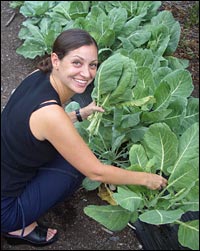
Maisie Ganzler.
What work do you do?
I’m director of communications and strategic initiatives for Bon Appétit Management Company.
How does it relate to the environment?
Bon Appétit is an onsite restaurant company committed to socially responsible practices. Our café and catering services feed about 200,000 people every day in corporations, colleges and universities, and museums. What sets us apart is that we pay close attention to where the food we serve comes from and its environmental impact. We also work closely with environmental and animal welfare groups such as Seafood Watch, Environmental Defense, and the Humane Society.
What are you working on at the moment?

Field of greens.
We just wrapped up our second annual Eat Local Challenge. This is a day where all 400 of our cafés serve a meal made completely of local ingredients. We always feature local items on our menus; our Farm to Fork program requires that our chefs purchase a minimum of 20 percent from local farmers. We normally combine the local items with more conventionally purchased ingredients, but for the Eat Local Challenge, every part of the meal must come from within a 150-mile radius of the kitchen. For example, if cheese is served, the cows and the artisan cheesemaker must both be local. The event was a huge success — fun for our chefs and educational for our guests.
This year, we also converted to cage-free eggs and continued our work on sustainable seafood.
How do you get to work?
I used to be the poster child for public transportation. I now, unfortunately, live in an area where driving is my only option for getting to work. I am an avid weekend cyclist, however.
What long and winding road led you to your current position?
With parents who work in the social services, I rebelled and went into the business world. However, the apple really doesn’t fall far from the tree: I’ve combined my professional ambition and personal ethics by working for a company with a strong social conscience.
I first learned about Bon Appétit when I was looking for my second job out of hotel management school at Cornell University. I wanted to work for the company so much that I was willing to join in almost any capacity. I started in 1994 as an employee services coordinator. At that point, our social responsibility was more covert. When my experience and confidence grew, I began focusing on the bigger picture, making strategic recommendations and ultimately creating a communications department to put a public face on our sustainable food sourcing and green business practices. By working closely with Fedele Bauccio, our CEO, and Marc Zammit, our director of culinary support and development, I’ve been able to help make Bon Appétit a model for what is possible in the food-service industry.
Where were you born? Where do you live now?
I grew up in Santa Cruz, Calif., and now live in Los Gatos, Calif.
What has been the worst moment in your professional life to date?
After my first 18 months, I left Bon Appétit to join a start-up restaurant company. I wasn’t sure that a company in a mature industry such as food service was the right place for me. By the end of my first week, I knew I had a made a mistake. I realized that it wasn’t the industry that had been holding me back — it was my own false perceptions. I saw that there was actually enormous possibility to think creatively at Bon Appétit. Our ethical business practices are the perfect example of how a mature company can be innovative and find completely unique ways to operate. I had also severely underestimated the value of working for a corporation with clear vision and strong leadership. I was very happy when they let me come back. I’ve now been here for almost 12 years and truly appreciate the opportunity to reinvent the meaning of institutional food service.
What’s been the best?
In 1999, we had what we call a “crisis of flavor.” Food didn’t taste the way we remembered it tasting. Many of us have childhood memories of eating a tomato like an apple. All of a sudden, tomatoes were mealy, flavorless things that you would never think of biting straight into. What happened? The agricultural system had changed. Food was grown to be shipped, not to taste good. As a company of culinarians, we knew something had to be done differently. We created our ground-breaking Farm to Fork program that year, mandating chefs buy as much food as possible from local producers. Cutting down on the distance our food was traveling meant that we could buy delicate heirloom produce harvested at the peak of ripeness. It also meant reinvesting in our communities and decreasing greenhouse-gas emissions from transportation. In 2004, we rewrote our Bon Appétit mission statement to formally incorporate our commitment to socially responsible practices. This was recognition that the way in which we produce our food — not just how it tastes — is a fundamental part of our business model. That was a very proud day.
What environmental offense has infuriated you the most?
Growing up in coastal California in the 1980s, offshore oil drilling was a looming threat. James Watt was Reagan’s secretary of the interior at the time and made innumerable ridiculous comments about the environment. I remember feeling shocked that I, at age 11, had a better grip on the issues than the man whose job it was to protect our environment.
Who is your environmental hero?
Jennifer Dianto, program manager for the Monterey Bay Aquarium’s Seafood Watch, has worked tirelessly to save our seas. She has crisscrossed the country speaking to anyone who would listen about the state of our oceans. By opening our eyes to the impact of our purchasing decisions, she has forever changed the way we do business at Bon Appétit. She showed us how much power we wield and how to use it for positive environmental change.

Ganzler’s preferred set of wheels.
What’s your environmental vice?
Definitely my car.
Read any good books lately?
I just read Stiff: The Curious Lives of Human Cadavers by Mary Roach. It brings new meaning to the idea of recycling.
What’s your favorite meal?
Vietnamese barbecue lemongrass beef over cold vermicelli noodles — I love the combination of the hot meat, cool noodles, and crunchy bean sprouts. Plus, I have an undying need for Vietnamese fish sauce — please don’t tell me the fish they use to make nuoc nam is on the Monterey Bay Aquarium Seafood Watch “Avoid” list. Actually, I think it is made from anchovies, so I’m safe.
Which stereotype about environmentalists most fits you?
I’m a bleeding-heart liberal.
What’s your favorite place or ecosystem?
The underwater world. I just came back from 10 days of snorkeling in Fiji. That was pretty amazing.
If you could institute by fiat one environmental reform, what would it be?
I would have food carry its actual cost — the true cost of production, which to me means a fair return to farmers, living wages for farm workers, and the reflection of the environmental impact of farming and transport methods. All of a sudden, local organic produce would look like the bargain that it is and processed foods full of empty calories would be prohibitively expensive.
Who was your favorite musical artist when you were 18? How about now?
My musical taste is surprisingly steady (or I’m just stuck in a huge rut). Then and now, the English Beat. It doesn’t hurt that lead singer Dave Wakeling is a supporter of Greenpeace and Heal the Bay. Gotta love a rocker who is trying to clean up the oceans.
What’s your favorite movie?
Which actor would play you in the story of your life?
Ashley Judd. C’mon, a girl can dream, right?
If you could have every InterActivist reader do one thing, what would it be?
Buy a share in a CSA (community-supported agriculture). That simple act would support our small farmers, decrease the carbon footprint of food miles, and ensure that we all eat fresh, great-tasting, healthy vegetables.
I know about local-food initiatives in different places throughout the country and I am skeptical. In the summer it is great, but the culinary arts are so focused on taste. Do you think that people will ever have the opinion that eating locally is more important than eating the things that taste amazing? If not, what do you think could inspire them? — John Pepper, Middlebury, Vt.

Maisie Ganzler, Bon Appétit Management Company.
Local food does taste amazing! Are there compromises? Absolutely. I’d rather not have a peach in December than eat one of those mealy, flavorless things imported from who-knows-where and sold in supermarkets.
You’re in Vermont, so local produce is in short supply in the winter, but you can still support local cheesemakers, artisan bakers, and meat producers. And what is more satisfying on a winter day than a roast chicken surrounded by root vegetables? The drippings caramelized with the sugar from beets and parsnips — yum! I’d take that over beefsteak tomatoes with buffalo mozzarella and basil (one of my favorite summertime treats) on any cold day.
Please describe some of the steps you’ve taken to inform your customers and their dining guests about the true “cost” of authentic and healthy food. — Pamela Corcoran, Roanoke, Va.
When I referred to the “true cost” of food, I was really asking to reveal the cost of the “cheap” produce and processed foods we see today in supermarkets and chain restaurants. The price we pay for these items at the register doesn’t take into account the enormous farm subsidies enjoyed by agribusiness, the health-care costs from obesity-related disease, the environmental cost of transporting food across the world, or the cost of destroying our topsoil.
Through educational campaigns like the Circle of Responsibility and our Eat Local Challenge, we’ve tried to start our guests thinking about these issues. I also suggest you watch The True Cost of Food, a fun lesson about the price of the food we eat.
What makes Bon Appétit stand apart from some of its competitors on college campuses, such as Sodexho? — Whit Jones, Northfield, Minn.
Bon Appétit was the first food-service company to address the issues of where our food comes from and the effect that has on our communities, environment, and well-being. That means we have an unparalleled depth of experience working with local farmers, cooperatives, and NGOs to create policies that are new to our industry and have meaningful impact. In fact, we have paved the way for other food-service companies and restaurants to be able to purchase locally by doing the early legwork with organizations such as Food Alliance and America Fresh to work out the kinks in the supply chain and develop systems that work for large-volume operations.
We also think of the local producers we work with as partners and try to aid them in making their businesses successful. For example, we favor direct relationships with farmers so that the benefit of our purchases goes into their pockets rather than to a distributing middleman. We also pay many farmers in seven days (instead of the standard 30 or even 180 that other companies use) to help ease their cash-flow problems. Our managers often pick up produce from suppliers who can’t afford trucks, and our chefs have been known to modify menus to help farmers who find themselves with shortages or overages.
For example, the Community Alliance With Family Farmers brought to our attention a farmer who had an abundance of late-harvest peaches. He feared that he had no outlet for the peaches, and that they would end up rotting on the trees or be picked only to rot in the box. Our Southern California Regional Vice President Cary Wheeland said, “We’ll take ’em … all of them!” The initiative was given to our district managers to start placing some case orders for the peaches. The case order for Eat Local Challenge day alone was over 70 cases. Each chef was challenged to create fun and exciting menu items using peaches, in order to keep the fruit from going to waste, to support the farmer, and to continue the sustainability chain in our community. I think that’s pretty special!
Maybe most importantly, all of the commitments we talk about apply to all 400 of our cafés nationwide, not only to specific “green” locations. Sustainability is not a marketing term to us; it is at the core of our business model. It is ingrained in our culture, valued at the highest executive levels, and worked toward on a daily basis.
My fellow student activists and I are trying to convince our university’s food-management company to incorporate some of the socially responsible practices that Bon Appétit has embraced. Do you have any advice for us? — Alison Nemirow, Chicago, Ill.
First of all, I applaud you for getting involved. We love hearing from students who care about food-related issues. My advice is to ask a lot of questions and then ask for incremental changes. Learn as much as you can from people who are dealing with the realities of these issues every single day, and then use that information to craft a meaningful yet reasonable request. For example, go to the farmers’ market and talk to farmers about what products are in good supply and what distribution mechanisms are in place. Then, go to your food-service managers with some easy wins that will make them feel successful right off the bat. Maybe there is an apple orchard near the college or a greenhouse operation that grows lettuce. See if you can connect the chef and the specific producer rather than demanding “more local food.”
Ten years ago, my college cafeteria was run by Bon Appétit but never did I hear a word about the company’s purchasing of local foods or sustainable practices. Why isn’t the word out to constituents about the company’s practices? — Katie Goetz, Palo Alto, Calif.
We are in a somewhat unique position of having marketing lagging behind practice rather than driving it. Ten years ago, when you were eating in a Bon Appétit café, we purchased local produce, meat, and baked goods simply because they were the best-tasting products, but we didn’t think of it as a “political act,” so we didn’t really talk about it. Honestly, we had no idea people would care. That changed for us a few years ago when consumers started asking questions, and we found we had a great story to tell.
One of my daily challenges is to strike the proper balance between effectively communicating our principles and not overwhelming our guests or becoming food “nags.” If you went to one of our cafés today, you would see more information than in years past, but to truly understand the depth of our passion, nothing beats a conversation with one of our chefs.
A recent New York Times was about the national consumer demand for animal products that come from farms treating their animals decently — a concrete way people are opposing factory-farming cruelty and environmental devastation. What has Bon Appétit already done when it comes to purchasing meat, eggs, and dairy from more humane sources? — Kelly Fields, Houston, Texas story
That was an interesting story. I think it captured some of the confusion consumers face in trying to navigate the sea of labels.
We were the first food-service company to purchase chicken raised only without the non-therapeutic use of medically important antibiotics and then first again to extend the policy to turkey. We led our industry in the move to cage-free eggs and took a very early stand on rBGH in milk. We are currently working to implement natural-beef burgers in every café. We’re most of the way there but still need to find steady sources for some of our more remote locations.
Our CEO, Fedele Bauccio, serves on the Pew Commission for Animal Husbandry, so look for us to continue to be on the leading edge of these issues.
What do you see as the biggest challenge to incorporating local foods into the food-service industry? — A. Rood, Berkeley, Calif.
The biggest challenge is going to be modifying purchasing systems. Unlike Bon Appétit, most companies make purchasing decisions centrally with one person negotiating national contracts. Purchasing locally means empowering individual chefs and managers to find their own sources and strike their own deals. That’s a big change for most large companies.
Does every single ingredient in the food served for Eat Local Challenge day come from within a 150-mile radius, including the cooking oil, seasonings, etc.? — Marco Negro, New York
For the Eat Local Challenge, every single ingredient must come from within a 150-mile radius with the only exception being salt (however many of our chefs went the extra step to make their own local salt). That means if you are going to serve bread, the wheat, yeast, sugar, everything has to come from within 150 miles. Our chefs were able to create amazing, diverse meals using ingredients from their food sheds.
Do you have any suggestions on books or websites where I could find out more about local foods and CSAs? — Kevin McCluney, Tempe, Ariz.
A great place to start is LocalHarvest. They have an excellent search feature that allows you to easily find farmers’ markets and CSAs in your area. I also really enjoyed, and learned a lot from, the documentary The Real Dirt on Farmer John.
You mention sustainable seafood. I was just wondering what that is. — Derrick Nicholson, Kelowna, British Columbia, Canada
Sustainable seafood is from sources, either fished or farmed, that can maintain or increase production in the long-term without jeopardizing the affected ecosystems. For more information, check out Seafood Watch.
Do you ever give keynote addresses? — David Andrews, Des Moines, Iowa
Funny you should ask. I’m actually addressing the National Catholic Rural Life Center’s Annual Conference in a couple weeks. They have an incredible program called Eating is a Moral Act.


